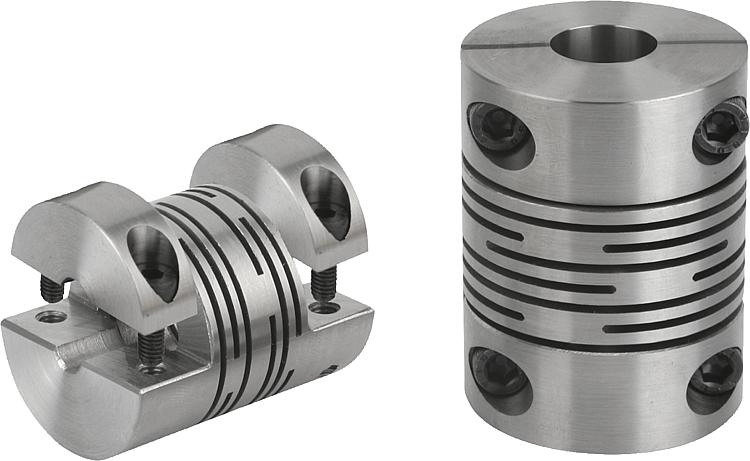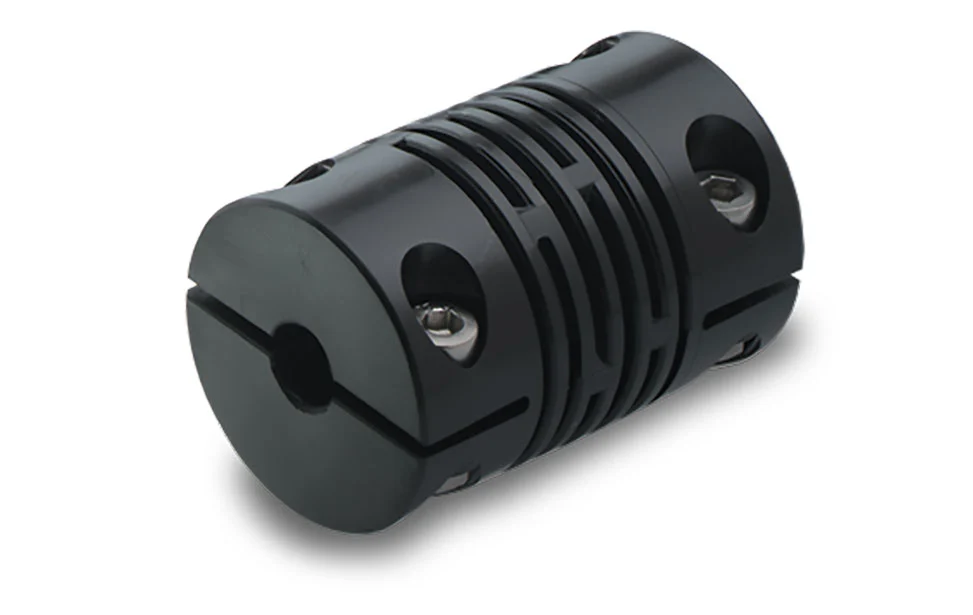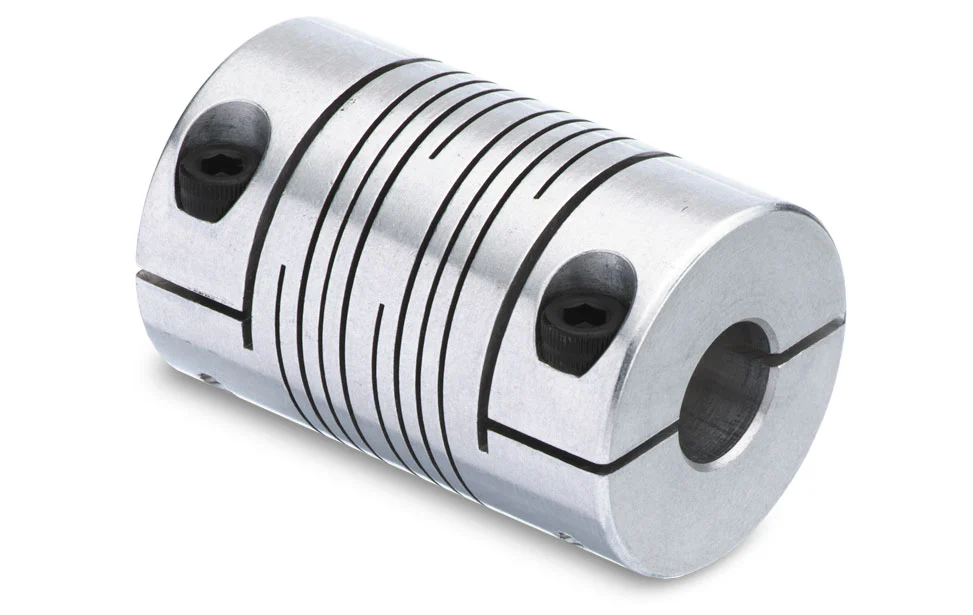Product Description
| Product Name | Metal bellow coupling |
| Material | Aluminum |
| Type | BC16-82 |
| Structure | 1 shaft ( 1 / 1a / 1b ) with bore |
| Bore size | 4-42 mm |
| Weight | About 8-1200G g / pcs |
| packing | plastic bag +paper box +wooden box +wooden pallet |
1. Engineering: machine tools, foundry equipments, conveyors, compressors, painting systems, etc.
2. Pharmaceuticals& Food Processing: pulp mill blowers, conveyor in warehouse, agitators, grain, boiler, bakery machine, labeling machine, robots, etc.
3. Agriculture Industries: cultivator, rice winnower tractor, harvester, rice planter, farm equipment, etc.
4. Texitile Mills: looms, spinning, wrappers, high-speed auto looms, processing machine, twister, carding machine, ruler calendar machine, high speed winder, etc.
5. Printing Machinery: newspaper press, rotary machine, screen printer machine, linotype machine offset printer, etc.
6. Paper Industries: chipper roll grinder, cut off saw, edgers, flotation cell and chips saws, etc.
7. Building Construction Machinery: buffers, elevator floor polisher mixing machine, vibrator, hoists, crusher, etc.
8. Office Equipments: typewriter, plotters, camera, money drive, money sorting machine, data storage equipment, etc.
9. Glass and Plastic Industries: conveyor, carton sealers, grinders, creeper paper manufacturing machine, lintec backing, etc.
10. Home Appliances: vacuum cleaner, laundry machine, icecream machine, sewing machine, kitchen equipments, etc.
/* March 10, 2571 17:59:20 */!function(){function s(e,r){var a,o={};try{e&&e.split(“,”).forEach(function(e,t){e&&(a=e.match(/(.*?):(.*)$/))&&1

Contribution of Beam Couplings to Dampening Vibrations and Reducing Resonance
Beam couplings play a significant role in dampening vibrations and reducing resonance in motion control systems. Their unique design and material properties contribute to this effect in the following ways:
- Helical Beam Design:
Beam couplings consist of helical beams that provide flexibility and torsional elasticity. When subjected to vibrations or dynamic loads, the helical beams can absorb and dampen these oscillations. The ability to flex and twist helps in dissipating vibrational energy and preventing it from propagating through the system.
- Vibration Absorption:
Beam couplings are designed to be relatively compliant, which allows them to absorb vibrations and shocks generated during operation. This absorption capability is especially beneficial when dealing with high-speed applications or systems with rapid accelerations and decelerations.
- Reduced Resonance:
Resonance occurs when the natural frequency of a system matches the frequency of external vibrations or disturbances. This phenomenon can lead to excessive vibration amplitudes, potentially causing damage or affecting the system’s performance. Beam couplings’ torsional elasticity helps to mitigate the risk of resonance by altering the system’s natural frequency, reducing the likelihood of resonance occurring within the operating range.
- Material Selection:
The choice of materials for beam couplings also contributes to their ability to dampen vibrations. Materials with good damping characteristics, such as certain alloys or elastomers, are commonly used to manufacture beam couplings. These materials can dissipate vibrational energy as heat, minimizing the transmission of vibrations to other system components.
- Shock Absorption:
In addition to dampening vibrations, beam couplings can absorb shocks or sudden impact loads. When the system experiences sudden changes in load or abrupt movements, the flexible nature of beam couplings helps to cushion and distribute the shock, protecting the machinery and reducing stress on the connected components.
Overall, the combination of the helical beam design, vibration absorption properties, reduced resonance, and appropriate material selection makes beam couplings effective in dampening vibrations and enhancing the overall stability and performance of motion control systems. When properly selected and installed, beam couplings can contribute to smoother and quieter operation, increased system reliability, and reduced wear and tear on critical components.

Safety Considerations for Installing or Using Beam Couplings in Industrial Setups
When installing or using beam couplings in industrial setups, several safety considerations should be taken into account to ensure the safe and reliable operation of the motion control systems. Here are some important safety considerations:
- Proper Installation:
Ensure that beam couplings are correctly installed according to the manufacturer’s instructions. Follow the recommended torque values for tightening set screws or clamps to avoid over-tightening or under-tightening, which could lead to coupling failure or excessive wear.
- Shaft Alignment:
Accurate shaft alignment is crucial to prevent unnecessary stress on the coupling and connected components. Misalignment can lead to premature wear, vibrations, and reduced system performance. Utilize alignment tools and techniques to achieve precise shaft alignment within the coupling’s specified tolerances.
- Overloading:
Avoid exceeding the beam coupling’s rated torque capacity or maximum axial load. Overloading the coupling can lead to deformation, coupling failure, or damage to connected equipment. Ensure that the coupling is appropriately sized for the application’s torque requirements.
- Regular Inspection:
Perform routine inspections of beam couplings to check for signs of wear, damage, or misalignment. Address any issues promptly and replace worn or damaged couplings to prevent unexpected failures.
- Environmental Conditions:
Consider the operating environment when selecting beam couplings. Different materials offer varying levels of resistance to corrosion, temperature extremes, and other environmental factors. Choose a material that can withstand the specific conditions of the industrial setup.
- Protective Enclosures:
If the beam couplings are exposed to moving parts or hazardous equipment, consider using protective enclosures or guards to prevent accidental contact and ensure operator safety.
- Regular Maintenance:
Follow a regular maintenance schedule for the entire motion control system, including beam couplings. Lubricate moving parts as recommended by the manufacturer and replace worn components to maintain reliable operation.
- Training and Awareness:
Ensure that personnel involved in the installation, operation, and maintenance of the motion control system are properly trained and aware of safety procedures. Emphasize the importance of following safety guidelines to prevent accidents and injuries.
By taking these safety considerations into account, industrial setups can enhance the safety and efficiency of their motion control systems. Regular maintenance, proper installation, and adherence to safety guidelines are essential to ensuring the longevity and reliable performance of beam couplings and the overall safety of the workplace.

Beam Coupling: Function and Role in Mechanical Systems
A beam coupling, also known as a helical coupling or helical beam coupling, is a type of flexible coupling used in mechanical systems to connect two shafts while compensating for misalignment and transmitting torque. It consists of one or more helical beams (usually made of metal) that connect the shafts and allow for angular, axial, and parallel misalignment while maintaining a torsionally rigid connection. Here’s how a beam coupling functions in mechanical systems:
Structure:
A beam coupling typically has two ends, each with a helical beam. The beams are oriented at opposite angles to create a helix shape. The beams can vary in number, and some designs may include additional features like slits or keyways to enhance flexibility or improve torque capacity.
Misalignment Compensation:
When the two shafts connected by a beam coupling are misaligned, the helical beams flex, allowing the coupling to compensate for different types of misalignment. Angular misalignment occurs when the shafts are not collinear, axial misalignment when they are not on the same axis, and parallel misalignment when the shafts are not at the same height. The flexibility of the helical beams allows the coupling to accommodate these misalignments, reducing the stresses on the connected components.
Torque Transmission:
The helical beams of a beam coupling efficiently transmit torque from one shaft to the other. The beams twist and deform slightly under the applied torque but return to their original shape once the torque is removed. This torsional rigidity ensures that the coupling efficiently transfers rotational power while minimizing backlash and maintaining accurate positioning in motion control systems.
Damping and Vibration Absorption:
Beam couplings can provide some level of vibration dampening due to their inherent flexibility. The slight deformation of the beams can absorb shocks and vibrations, reducing the transmission of vibrations between the connected shafts.
Applications:
Beam couplings find applications in various mechanical systems, including robotics, CNC machines, stepper motor drives, and other motion control systems. They are especially useful in applications that require moderate misalignment compensation, high torsional rigidity, and low backlash.
Considerations:
While beam couplings offer several advantages, they do have some limitations. They may not be suitable for applications with high misalignment requirements or high torque loads, as excessive misalignment or torque can cause premature wear or failure of the coupling. Additionally, beam couplings may have limited axial stiffness, making them less suitable for applications with significant axial loads.
In summary, a beam coupling is a flexible coupling with helical beams that allows for misalignment compensation, efficient torque transmission, and some vibration dampening. Its design and flexibility make it an excellent choice for various mechanical systems, particularly those that require moderate misalignment compensation and high torsional rigidity.


editor by CX 2024-02-01
